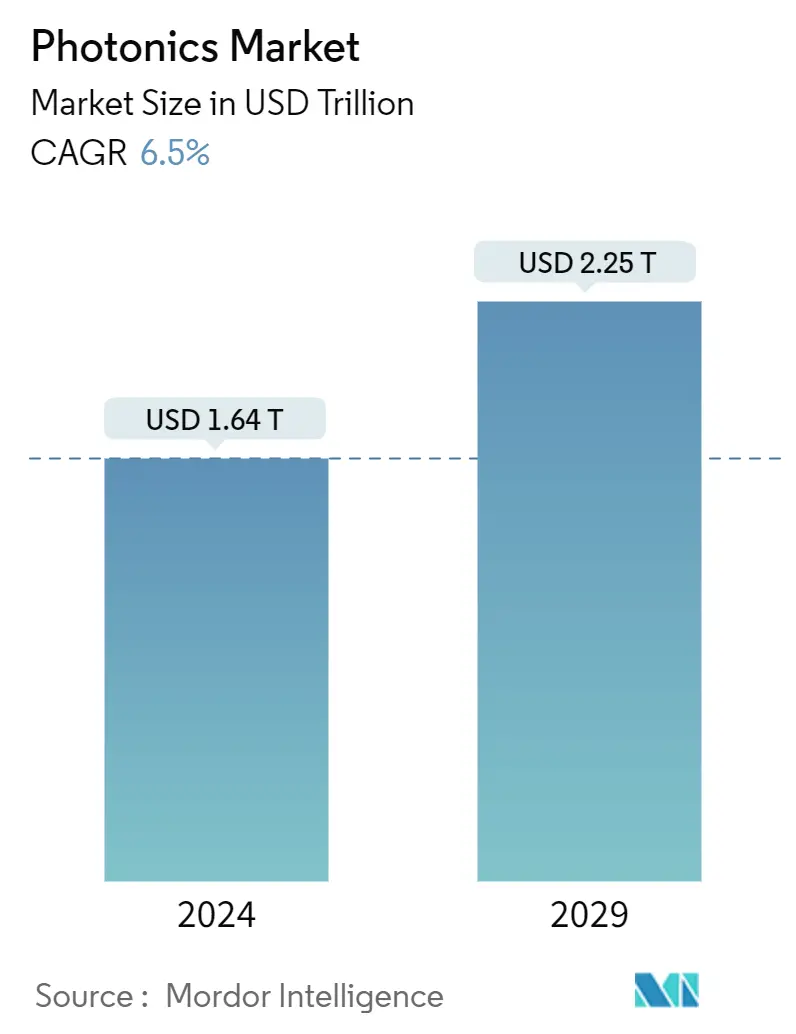Market Size of Photonics Industry

| Study Period | 2019-2029 |
| Market Size (2024) | USD 1.64 Trillion |
| Market Size (2029) | USD 2.25 Trillion |
| CAGR (2024 - 2029) | 6.50 % |
| Fastest Growing Market | Asia Pacific |
| Largest Market | Asia Pacific |
Major Players
*Disclaimer: Major Players sorted in no particular order |
Need a report that reflects how COVID-19 has impacted this market and its growth?
Photonics Market Analysis
The Photonics Market size is estimated at USD 1.64 trillion in 2024, and is expected to reach USD 2.25 trillion by 2029, growing at a CAGR of 6.5% during the forecast period (2024-2029).
Photonics involves radiant energy (such as light), whose fundamental element is the photons and waves that can cure diseases, explore the universe, and even solve crimes. It involves the generation, manipulation, transmission, detection, and utilization of light and other forms of electromagnetic radiation. It is widely regarded as a critical enabling technology for developing smart systems that efficiently use energy without sacrificing overall system efficiency. Many verticals, including healthcare, automotive, communications, manufacturing, and retail, are leveraging the technology to attain higher efficiency, driving growth. Investments from these sectors also have witnessed significant growth in the recent past.
- With photonics being a core technology of multiple industries, the consumption of the technology is witnessing rapid growth, with the market expanding in new verticals. Over the past few years, there has been an increasing trend of LiDAR or additive manufacturing in photonics. LiDAR has been used to study the atmosphere's distribution of gases and contaminants for decades. In recent years, it has become a critical technology for autonomous driving. The advancements in LiDAR mapping systems and their enabling technologies penetrated different verticals, like aerospace and defense, corridor mapping and topographical survey, automotive, mining, oil and gas, and other verticals, which are increasing the market scope.
- In the United States, the presence of industry giants such as Google, Microsoft, and Facebook is the primary force driving the photonics market, necessitating optimizing the data transmission process for respective data centers. The country also provides a favorable environment for technological advancements and expansions. Furthermore, the significant funding landscape in the United States silicon photonics devices industry has encouraged organizations and start-ups to invest in the expanding photonics market.
- Moreover, an article titled "A Survey on Silicon Photonic in Deep Learning," published by the Association of Computing Machinery, stated that deep learning has led to exceptional success in solving some extremely tough problems in disciplines, including computer vision, natural language processing, and general pattern recognition. These achievements are the product of decades of research into better training methodology and deeper neural network models, as well as developments in deep neural network hardware platforms for training and execution. Many application-specific integrated circuit (ASIC) hardware accelerators for deep learning have received attention in recent years due to their improved performance and energy efficiency over standard CPU and GPU designs.
- Industries require a high level of initial investment to integrate such photonics technology for automation purposes. The high cost of automated systems is concerned with effective and robust hardware and efficient software. Automation equipment requires high capital investment to invest in smart production (an automated system can cost millions of dollars to install, design, and fabricate). Thus, industries rely on the existing technologies available at a lower price, ultimately challenging the adoption.
- Apart from the direct impact evident in the supply chains and production of photonic solutions, the aftereffects of the pandemic are also impacting the growth of the market studied. For instance, the ongoing threat of recession looming over various regions, including the United States, may negatively influence the market's growth, as the economic uncertainty will prevent consumers and businesses from spending more on high-value products, which may impact the growth of the market studied.
- The COVID-19 pandemic influenced the overall semiconductor manufacturing market from the demand and supply sides. In addition, the global lockdowns and closure of semiconductor plants also fueled the supply shortage. The effects were also reflected in the market studied. However, many of these effects were short-term. Precautions by governments worldwide to support automotive and semiconductor sectors helped revive industry growth.
